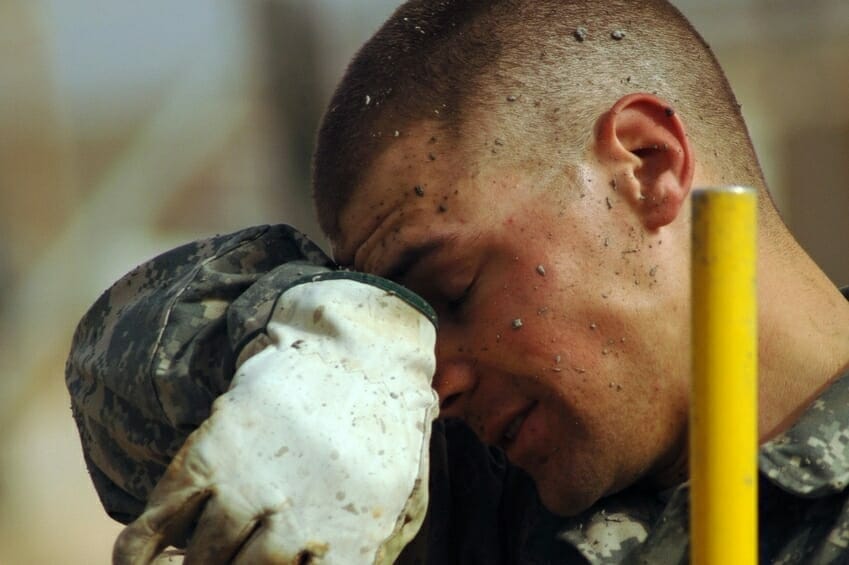According to the EPA, extreme heat is the cause of more than 1,300 deaths per year in the United States. And it probably comes as no surprise that the weather experts at the National Oceanic and Atmospheric Administration (NOAA) have predicted a hotter than normal 2018 summer in much of the U.S. Whether or not you accept the theory of global warming, the fact is that every summer in Houston, it’s not only hot, but humid! Our dog days of summer can begin as early as April and last into October.
Summers take a toll on many construction sites. Construction workers are at the high end of the risk spectrum for construction worker accidents due to the strenuous nature of their jobs and constant exposure to our summer heat and humidity. Workers who run the highest risks of heat-related dangers include roofers, road construction gangs, and workers inside a building with no air conditioning and poor ventilation. These heat-related dangers can land workers in the emergency room – or worse.
Heat cramps are the mildest form of heat-related illness. They are typically caused by the loss of body salts and fluids from sweating. To keep heat cramps from becoming serious, workers should replace fluid loss by drinking water or electrolyte-containing beverages and rest in a cool area until the cramps have subsided for at least ten minutes.
Heat exhaustion results from extended periods of exposure to oppressively high temperatures and loss of fluids and salts. The symptoms of heat exhaustion are headache, nausea, dizziness, weakness, irritability, confusion, thirst, and heavy sweating. Construction workers who suffer from heat exhaustion must be moved to a cool area and given frequent sips of cool (not icy cold) water. Cold compresses to the head, neck, and face also help lower body temperature.
Heat stroke is the most dangerous heat-related illness, shutting down the body’s ability to cool itself. If not treated immediately, heat stroke can be fatal. The warning signs are high body temperature, seizures, confusion, and loss of consciousness. If an employee is experiencing a heat stroke, call 9-1-1 immediately and treat them as you would someone with heat exhaustion.
All construction employees who work outdoors need access to the following aids to help control their body temperature:
Hydration Stations – There should be water coolers or cold water bottles in break rooms or easily accessible shaded areas to help employees stay hydrated. Workers should drink at least a liter of water every hour – one cup every 15 minutes – to better resist heat-related distress.
Altering shift schedules – If possible, workers should avoid exposure to heat in the mid-to-late afternoon, when it is at its peak. This could involve scheduling physically demanding work in the mornings or evenings and less physical work – or even long breaks – in the afternoons.
Regular breaks – Employers should require workers to take a five-minute “time out” each hour, to rest in cool shady areas and rehydrate.
Acclimatization – Acclimatization is a physical change that allows the body to build tolerance to working in the heat. It occurs by gradually increasing workloads and exposure. Full acclimatization can take as long as two weeks, depending on the worker. New workers and those returning from a prolonged absence or vacations should begin with 20% of normal workload on the first day, then increase incrementally by no more than 20% each subsequent day. If you’re seeking legal guidance during this process, it’s important to consult with a skilled worker compensation lawyer. During excessively hot weather such as a when a “heat advisory” is issued, even experienced workers should begin on the first day of work in excessive heat with 50% of the normal workload and time spent in the hot environment, 60% on the second day, 80% on day three, and 100% on the fourth day.
Personal Protective Equipment that Effectively Minimizes Heat Stress – Outdoor workers should try to secure any or all of the following to help them work more comfortably in Houston’s brutal daytime heat:
- Reflective clothing
- Auxiliary body-cooling ice vests
- Wet clothing/water-cooled garments.
If you have suffered a workplace injury and want to speak to an attorney about your legal options, don’t hesitate to contact the accident and injury law office of Terry Bryant to schedule a free consultation. Our team includes experienced construction accident cases experts who can provide you with valuable insights and guidance tailored to your specific situation.
Attorney Terry Bryant
 Terry Bryant is Board Certified in personal injury trial law, which means his extensive knowledge of the law has been recognized by the Texas Board of Legal Specialization, setting him apart from many other injury attorneys. The 22 years he spent as a Municipal Judge, Spring Valley Village, TX also provides him keen insight into the Texas court system. That experience also helps shape his perspective on personal injury cases and how they might resolve. This unique insight benefits his clients. [ Attorney Bio ]
Terry Bryant is Board Certified in personal injury trial law, which means his extensive knowledge of the law has been recognized by the Texas Board of Legal Specialization, setting him apart from many other injury attorneys. The 22 years he spent as a Municipal Judge, Spring Valley Village, TX also provides him keen insight into the Texas court system. That experience also helps shape his perspective on personal injury cases and how they might resolve. This unique insight benefits his clients. [ Attorney Bio ]


 Terry Bryant is Board Certified in personal injury trial law, which means his extensive knowledge of the law has been recognized by the Texas Board of Legal Specialization, setting him apart from many other injury attorneys. The 22 years he spent as a Municipal Judge, Spring Valley Village, TX also provides him keen insight into the Texas court system. That experience also helps shape his perspective on personal injury cases and how they might resolve. This unique insight benefits his clients. [
Terry Bryant is Board Certified in personal injury trial law, which means his extensive knowledge of the law has been recognized by the Texas Board of Legal Specialization, setting him apart from many other injury attorneys. The 22 years he spent as a Municipal Judge, Spring Valley Village, TX also provides him keen insight into the Texas court system. That experience also helps shape his perspective on personal injury cases and how they might resolve. This unique insight benefits his clients. [ 

